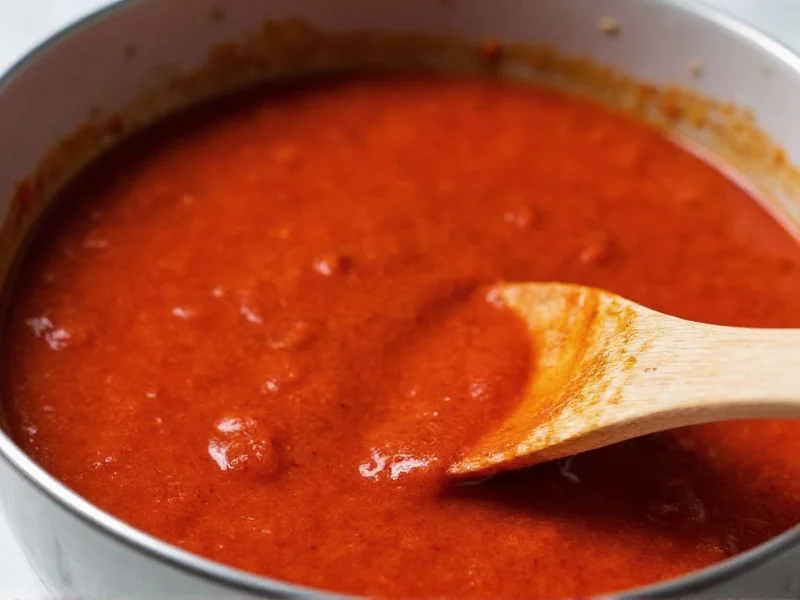Understanding exactly what does harissa sauce taste like requires exploring its multi-dimensional flavor profile. This North African condiment creates a distinctive sensory experience that goes far beyond simple heat. Authentic harissa balances fiery elements with nuanced flavors that develop as you taste it.
The Core Flavor Components of Harissa
Harissa's signature taste emerges from several key elements working in harmony:
- Pepper Foundation - Primarily made from Baklouti peppers in Tunisia (where harissa originated), though many commercial versions use serrano or other chili peppers. These provide the base heat that ranges from 4,000-8,000 Scoville units - noticeably spicy but generally milder than habanero-based sauces
- Smoky Depth - Traditional preparation involves roasting peppers over open flame, creating complex smoky notes similar to chipotle but with more brightness
- Acidic Balance - Lemon juice or vinegar cuts through the heat and oil, providing necessary brightness that prevents the sauce from feeling heavy
- Spice Complexity - Ground cumin, coriander, and caraway add earthy, almost floral notes that distinguish harissa from simpler hot sauces
- Garlic Essence - Fresh garlic contributes pungent depth that mellow when cooked
- Olive Oil Richness - High-quality versions use extra virgin olive oil which adds fruitiness and helps distribute flavors
Texture and Aroma Profile
Before even tasting, harissa announces itself through aroma. The scent combines roasted pepper smoke with citrus top notes and underlying spice warmth. When poured, authentic harissa has a thick, paste-like consistency that coats the spoon - thinner than tomato paste but thicker than standard hot sauce.
When evaluating what does traditional harissa taste like, note that the texture significantly impacts the flavor release. The thick paste clings to food, allowing flavors to develop gradually rather than hitting all at once like liquid hot sauces.
Regional and Brand Variations
Understanding how would you describe harissa requires acknowledging significant variations:
| Variation Type | Flavor Characteristics | Heat Level |
|---|---|---|
| Traditional Tunisian | Smoky, complex spice blend, noticeable garlic | Moderate (4,000-6,000 SHU) |
| Commercial (US Market) | Simplified spice profile, often sweeter, less smoky | Variable (2,000-10,000 SHU) |
| Homemade | Most complex, customizable heat and spice levels | Adjustable to preference |
| Moroccan Style | Milder, more herb-forward, less smoky | Mild to moderate (2,000-5,000 SHU) |
These differences explain why someone asking is harissa sauce spicy or sweet might receive conflicting answers. Authentic versions prioritize complex heat over sweetness, though some American brands add sugar to appeal to broader palates.
How Harissa's Flavor Functions in Cooking
The magic of harissa reveals itself when used in cooking. Unlike many hot sauces that primarily add heat, harissa contributes multiple flavor dimensions:
- Raw Application - When used as a finishing sauce or in dressings, harissa delivers immediate heat with pronounced garlic and citrus notes
- Cooked Integration - When sautéed in oil or incorporated into stews, the flavors mellow and deepen, with spices becoming more integrated and heat distributing evenly
- Marinade Magic - The acid and oil components help harissa penetrate proteins while the spices create complex crusts when grilled
When exploring what does harissa taste like in recipes, note that cooking transforms its profile. The initial sharp heat softens into a warm glow, while smoky and earthy notes become more pronounced. This evolution makes harissa incredibly versatile across cooking applications.
Harissa Compared to Other Popular Condiments
Understanding harissa vs other hot sauces taste helps contextualize its unique profile:
- Harissa vs Sriracha - While sriracha delivers straightforward garlic-chili heat with significant sugar content, harissa offers more complex smokiness and earthy spices with less sweetness
- Harissa vs Gochujang - Korean gochujang provides fermented umami depth and noticeable sweetness, while harissa emphasizes fresh pepper brightness and citrus notes
- Harissa vs Chipotle Sauce - Both offer smokiness, but chipotle sauce typically has more vinegar punch and less complex spice elements than quality harissa
These distinctions explain why culinary enthusiasts seeking what does harissa sauce taste like compared to other options find it occupies a unique space in the condiment landscape - more complex than basic hot sauces but brighter than deeply fermented options.
Tips for First-Time Harissa Users
If you're experiencing harissa for the first time, consider these tips for appreciating its full flavor profile:
- Start with small amounts - 1/4 to 1/2 teaspoon in dressings or marinades
- Let it sit for 15-20 minutes after mixing with other ingredients to allow flavors to integrate
- Try it both raw (in yogurt dips) and cooked (in stews) to experience its range
- Balance with cooling elements like yogurt or avocado if heat overwhelms initially
- Look for versions with minimal ingredients (peppers, spices, garlic, olive oil, acid) for most authentic harissa sauce taste description
Remember that quality harissa shouldn't taste like does harissa taste like chipotle exclusively - while both offer smokiness, harissa's complexity comes from its spice blend and brighter acidity. The best versions create a flavor journey that begins with heat, transitions to smoky depth, and finishes with earthy spice notes.











 浙公网安备
33010002000092号
浙公网安备
33010002000092号 浙B2-20120091-4
浙B2-20120091-4